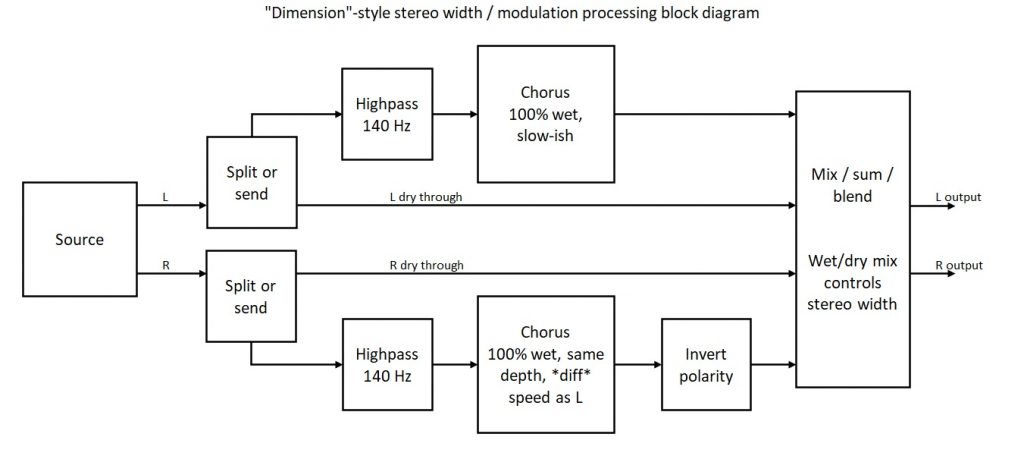The Boss Dimension C / Dimension D effects are famous for their seemingly unmoving modulation, providing a widening and deepening* effect on sounds without being warbly like a traditional chorus effect.
Here’s how the same effect can be created and customized in almost any DAW. I use this often for turning mono synth signals into stereo.

It takes four channels of audio. In Reaper I do this all in one track, with an extra set of track channels and plug-in pins. In ProTools you might use a send from the main track to a stereo auxiliary or two mono auxiliaries. The details will vary; the important thing is four channels, Ls panned 100% left and Rs panned 100% right.
The signal path:
Source – Can be mono or stereo
Split/send – Duplicate both the left and right channels of audio so there are 4 total (4 track channels in Reaper, original track plus two mono aux tracks in ProTools, etc.). One L/R pair (the “dry” signal) will go straight through to the mix stage with no further processing
Highpass (“wet” signal) – Adjust this to taste. On an individual sound source like a mono synth sound this could be skipped. On a full mix with drums, bass, and other sounds, I probably wouldn’t set it much lower than 140 Hz but I might set it higher; 200, even 300 Hz. The reason for this is to keep bass frequencies from bouncing back and forth between left and right
Chorus – The different sides of the wet L/R pair need different chorus settings, so you’ll almost certainly need two instances of your chorus plugin (this is where two mono auxes can be helpful in ProTools, rather than a stereo wet aux). Both need to be set to 100% wet output. Adjust depth to taste but use the same depth on both sides. To the best of my knowledge the original Dimension effects use the same medium-slow chorus rate/speed on both sides, with the LFO polarity inverted for one side (so when the L channel is high the R channel is low, and vice versa). I like just using slightly different rates for a less predictable, almost polyrhythmic type of movement
Invert polarity – This is key; invert the polarity of *one* of the wet channels. This has the result of phase-cancelling frequencies that are the same in both channels, leaving only the differences (like mid/side processing)
Mix – Bring it all together. In Reaper I use an 8-to-2 track channel mixer to mix back down to stereo. In ProTools with auxes your “mixer” is just your master track, and you mix via the volume levels on your dry and wet tracks. The more wet-to-dry in the mix, the wider the stereo image will be.
By creating our own processing instead of using a Dimension unit we can have greater clarity (bypassing the hardware’s inevitable amp stages and filtering) and control (setting our own high pass cutoff, chorus rates, and mix levels), making new sounds in the process.
My hat is off to whoever came up with the idea for this circuit, though, it’s truly brilliant and sounds fantastic.
*Creating “dimension,” natch
